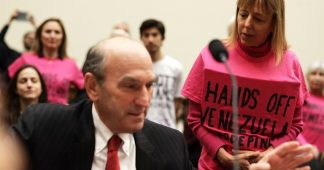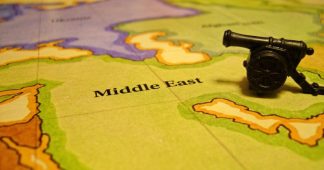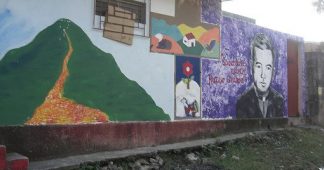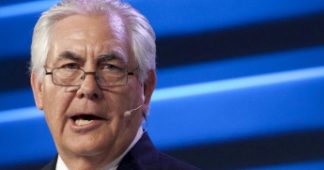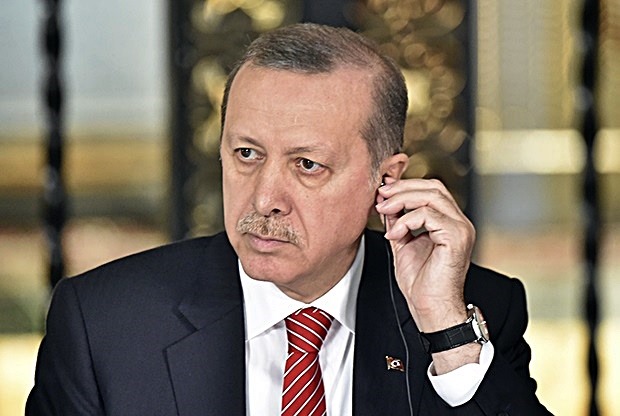By Jon Schwarz
J
On December 11, 1981 in El Salvador, a Salvadoran military unit created and trained by the U.S. Army began slaughtering everyone they could find in a remote village called El Mozote. Before murdering the women and girls, the soldiers raped them repeatedly, including some as young as 10 years old, and joked that their favorites were the 12-year-olds. One witness described a soldier tossing a 3-year-old child into the air and impaling him with his bayonet. The final death toll was over 800 people.
The next day, December 12, was the first day on the job for Elliott Abrams as assistant secretary of state for human rights and humanitarian affairs in the Reagan administration. Abrams snapped into action, helping to lead a cover-up of the massacre. News reports of what had happened, Abrams told the Senate, were “not credible,” and the whole thing was being “significantly misused” as propaganda by anti-government guerillas.
This past Friday, Secretary of State Mike Pompeo named Abrams as America’s special envoy for Venezuela. According to Pompeo, Abrams “will have responsibility for all things related to our efforts to restore democracy” in the oil-rich nation.
The choice of Abrams sends a clear message to Venezuela and the world: The Trump administration intends to brutalize Venezuela, while producing a stream of unctuous rhetoric about America’s love for democracy and human rights. Combining these two factors — the brutality and the unctuousness — is Abrams’s core competency.
Abrams previously served in a multitude of positions in the Ronald Reagan and George W. Bush administrations, often with titles declaring their focus on morality. First, he was assistant secretary of state for international organization affairs (in 1981); then the State Department “human rights” position mentioned above (1981-85); assistant secretary of state for inter-American affairs (1985-89); senior director for democracy, human rights, and international operations for the National Security Council (2001-05); and finally, Bush’s deputy national security adviser for global democracy strategy (2005-09).
In these positions, Abrams participated in many of the most ghastly acts of U.S. foreign policy from the past 40 years, all the while proclaiming how deeply he cared about the foreigners he and his friends were murdering. Looking back, it’s uncanny to see how Abrams has almost always been there when U.S. actions were at their most sordid.
Abrams, a graduate of both Harvard College and Harvard Law School, joined the Reagan administration in 1981, at age 33. He soon received a promotion due to a stroke of luck: Reagan wanted to name Ernest Lefever as assistant secretary of state for human rights and humanitarian affairs, but Lefever’s nomination ran aground when two of his own brothers revealed that he believed African-Americans were “inferior, intellectually speaking.” A disappointed Reagan was forced to turn to Abrams as a second choice.
A key Reagan administration concern at the time was Central America — in particular, the four adjoining nations of Guatemala, El Salvador, Honduras, and Nicaragua. All had been dominated by tiny, cruel, white elites since their founding, with a century’s worth of help from U.S. interventions. In each country, the ruling families saw their society’s other inhabitants as human-shaped animals, who could be harnessed or killed as needed.
But shortly before Reagan took office, Anastasio Somoza, the dictator of Nicaragua and a U.S. ally, had been overthrown by a socialist revolution. The Reaganites rationally saw this as a threat to the governments of Nicaragua’s neighbors. Each country had large populations who similarly did not enjoy being worked to death on coffee plantations or watching their children die of easily treated diseases. Some would take up arms, and some would simply try to keep their heads down, but all, from the perspective of the cold warriors in the White House, were likely “communists” taking orders from Moscow. They needed to be taught a lesson.
El Salvador
The extermination of El Mozote was just a drop in the river of what happened in El Salvador during the 1980s. About 75,000 Salvadorans died during what’s called a “civil war,” although almost all the killing was done by the government and its associated death squads.
The numbers alone don’t tell the whole story. El Salvador is a small country, about the size of New Jersey. The equivalent number of deaths in the U.S. would be almost 5 million. Moreover, the Salvadoran regime continually engaged in acts of barbarism so heinous that there is no contemporary equivalent, except perhaps ISIS. In one instance, a Catholic priest reported that a peasant woman briefly left her three small children in the care of her mother and sister. When she returned, she found that all five had been decapitated by the Salvadoran National Guard. Their bodies were sitting around a table, with their hands placed on their heads in front of them, “as though each body was stroking its own head.” The hand of one, a toddler, apparently kept slipping off her small head, so it had been nailed onto it. At the center of the table was a large bowl full of blood.
Criticism of U.S. policy at the time was not confined to the left. During this period, Charles Maechling Jr., who had led State Department planning for counterinsurgencies during the 1960s, wrote in the Los Angeles Times that the U.S. was supporting “Mafia-like oligarchies” in El Salvador and elsewhere and was directly complicit in “the methods of Heinrich Himmler’s extermination squads.”
Abrams was one of the architects of the Reagan administration’s policy of full-throated support for the Salvadoran government. He had no qualms about any of it and no mercy for anyone who escaped the Salvadoran abattoir. In 1984, sounding exactly like Trump officials today, he explained that Salvadorans who were in the U.S. illegally should not receive any kind of special status. “Some groups argue that illegal aliens who are sent back to El Salvador meet persecution and often death,” he told the House of Representatives. “Obviously, we do not believe these claims or we would not deport these people.”
Even when out of office, 10 years after the El Mozote massacre, Abrams expressed doubt that anything untoward had occurred there. In 1993, when a United Nations truth commission found that 95 percent of the acts of violence that had taken place in El Salvador since 1980 had been committed by Abrams’s friends in the Salvadoran government, he called what he and his colleagues in the Reagan administration had done a “fabulous achievement.”
Guatemala
The situation in Guatemala during the 1980s was much the same, as were Abrams’s actions. After the U.S. engineered the overthrow of Guatemala’s democratically elected president in 1954, the country had descended into a nightmare of revolving military dictatorships. Between 1960 and 1996, in another “civil war,” 200,000 Guatemalans were killed — the equivalent of maybe 8 million people in America. A U.N. commission later found that the Guatemalan state was responsible for 93 percent of the human rights violations.
Efraín Ríos Montt, who served as Guatemala’s president in the early 1980s, was found guilty in 2013, by Guatemala’s own justice system, of committing genocide against the country’s indigenous Mayans. During Ríos Montt’s administration, Abrams called for the lifting of an embargo on U.S. arms shipments to Guatemala, claiming that Ríos Montt had “brought considerable progress.” The U.S. had to support the Guatemalan government, Abrams argued, because “if we take the attitude ‘don’t come to us until you’re perfect, we’re going to walk away from this problem until Guatemala has a perfect human rights record,’ then we’re going to be leaving in the lurch people there who are trying to make progress.” One example of the people making an honest effort, according to Abrams, was Ríos Montt. Thanks to Ríos Montt, “there has been a tremendous change, especially in the attitude of the government toward the Indian population.” (Ríos Montt’s conviction was later set aside by Guatemala’s highest civilian court, and he died before a new trial could finish.)
Nicaragua
Abrams would become best known for his enthusiastic involvement with the Reagan administration’s push to overthrow Nicaragua’s revolutionary Sandinista government. He advocated for a full invasion of Nicaragua in 1983, immediately after the successful U.S. attack on the teeny island nation of Grenada. When Congress cut off funds to the Contras, an anti-Sandinista guerrilla force created by the U.S., Abrams successfully persuaded the Sultan of Brunei to cough up $10 million for the cause. Unfortunately, Abrams, acting under the code name “Kenilworth,” provided the Sultan with the wrong Swiss bank account number, so the money was wired instead to a random lucky recipient.
Abrams was questioned by Congress about his Contra-related activities and lied voluminously. He later pleaded guilty to two counts of withholding information. One was about the Sultan and his money, and another was about Abrams’s knowledge of a Contra resupply C-123 plane that had been shot down in 1986. In a nice historical rhyme with his new job in the Trump administration, Abrams had previously attempted to obtain two C-123s for the Contras from the military of Venezuela.
Abrams received a sentence of 100 hours of community service and perceived the whole affair as an injustice of cosmic proportions. He soon wrote a book in which he described his inner monologue about his prosecutors, which went: “You miserable, filthy bastards, you bloodsuckers!” He was later pardoned by President George H.W. Bush on the latter’s way out the door after he lost the 1992 election.
Panama
While it’s been forgotten now, before America invaded Panama to oust Manuel Noriega in 1989, he was a close ally of the U.S. — despite the fact the Reagan administration knew he was a large-scale drug trafficker.
In 1985, Hugo Spadafora, a popular figure in Panama and its one-time vice minister for health, believed he had obtained proof of Noriega’s involvement in cocaine smuggling. He was on a bus on his way to Panama City to release it publicly when he was seized by Noriega’s thugs.
According to the book “Overthrow” by former New York Times correspondent Stephen Kinzer, U.S. intelligence picked up Noriega giving his underlings the go-ahead to put Spadafora down like “a rabid dog.” They tortured Spadafora for a long night and then sawed off his head while he was still alive. When Spadafora’s body was found, his stomach was full of blood he’d swallowed.
This was so horrific that it got people’s attention. But Abrams leapt to Noriega’s defense, blocking the U.S. ambassador to Panama from increasing pressure on the Panamanian leader. When Spadafora’s brother persuaded North Carolina’s hyper-conservative GOP Sen. Jesse Helms to hold hearings on Panama, Abrams told Helms that Noriega was “being really helpful to us” and was “really not that big a problem. … The Panamanians have promised they are going to help us with the Contras. If you have the hearings, it’ll alienate them.”
… And That’s Not All
Abrams also engaged in malfeasance for no discernible reason, perhaps just to stay in shape. In 1986 a Colombian journalist named Patricia Lara was invited to the U.S. to attend a dinner honoring writers who’d advanced “inter-American understanding and freedom of information.” When Lara arrived at New York’s Kennedy airport, she was taken into custody, then put on a plane back home. Soon afterward, Abrams went on “60 Minutes” to claim that Lara was a member of the “ruling committees” of M-19, a Colombian guerrilla movement. She also, according to Abrams, was ”an active liaison” between M-19 ”and the Cuban secret police.”
Given the frequent right-wing paramilitary violence against Colombian reporters, this painted a target on Lara’s back. There was no evidence then that Abrams’s assertions were true — Colombia’s own conservative government denied it — and none has appeared since.
Abrams’s never-ending, shameless deceptions wore down American reporters. “They said that black was white,” Joanne Omang at the Washington Post later explained about Abrams and his White House colleague Robert McFarlane. “Although I had used all my professional resources I had misled my readers.” Omang was so exhausted by the experience that she quit her job trying to describe the real world to try to write fiction.
Post-conviction Abrams was seen as damaged goods who couldn’t return to government. This underestimated him. Adm. William J. Crowe Jr., the one-time chair of the Joint Chiefs of Staff, tangled fiercely with Abrams in 1989 over the proper U.S. policy toward Noriega once it become clear he was more trouble than he was worth. Crowe strongly opposed a bright idea that Abrams had come up with: that the U.S. should establish a government-in-exile on Panamanian soil, which would require thousands of U.S. troops to guard. This was deeply boneheaded, Crowe said, but it didn’t matter. Crowe presciently issued a warning about Abrams: “This snake’s hard to kill.”
To the surprise of Washington’s more naive insiders, Abrams was back in business soon after George W. Bush entered the White House. It might have been difficult to get Senate approval for someone who had deceived Congress, so Bush put him in a slot at the National Security Council — where no legislative branch approval was needed. Just like 20 years before, Abrams was handed a portfolio involving “democracy” and “human rights.”
Venezuela
By the beginning of 2002, Venezuela’s president, Hugo Chavez, had become deeply irritating to the Bush White House, which was filled with veterans of the battles of the 1980s. That April, all of a sudden, out of nowhere, Chavez was pushed out of power in a coup. Whether and how the U.S. was involved is not yet known, and probably won’t be for decades until the relevant documents are declassified. But based on the previous 100 years, it would be surprising indeed if America didn’t play any behind-the-scenes role. For what it’s worth, the London Observer reported at the time that “the crucial figure around the coup was Abrams” and he “gave a nod” to the plotters. In any case, Chavez had enough popular support that he was able to regroup and return to office within days.
Iran
Abrams apparently did play a key role in squelching a peace proposal from Iran in 2003, just after the U.S. invasion of Iraq. The plan arrived by fax, and should have gone to Abrams, and then to Condoleezza Rice, at the time Bush’s national security adviser. Instead it somehow never made it to Rice’s desk. When later asked about this, Abrams’s spokesperson replied that he “had no memory of any such fax.” (Abrams, like so many people who thrive at the highest level of politics, has a terrible memory for anything political. In 1984, he told Ted Koppel that he couldn’t recall for sure whether the U.S. had investigated reports of massacres in El Salvador. In 1986, when asked by the Senate Intelligence Committee if he’d discussed fundraising for the contras with anyone on the NSC’s staff, he likewise couldn’t remember.)
Israel and Palestine
Abrams was also at the center of another attempt to thwart the outcome of a democratic election, in 2006. Bush had pushed for legislative elections in the West Bank and Gaza in order to give Fatah, the highly corrupt Palestinian organization headed by Yasser Arafat’s successor, Mahmoud Abbas, some badly needed legitimacy. To everyone’s surprise, Fatah’s rival Hamas won, giving it the right to form a government.
This unpleasant outburst of democracy was not acceptable to the Bush administration, in particular Rice and Abrams. They hatched a plan to form a Fatah militia to take over the Gaza Strip, and crush Hamas in its home territory. As reported by Vanity Fair, this involved a great deal of torture and executions. But Hamas stole a march on Fatah with their own ultra-violence. David Wurmser, a neoconservative who worked for Dick Cheney at the time, told Vanity Fair, “It looks to me that what happened wasn’t so much a coup by Hamas but an attempted coup by Fatah that was pre-empted before it could happen.” Yet ever since, these events have been turned upside down in the U.S. media, with Hamas being presented as the aggressors.
While the U.S. plan was not a total success, it also was not a total failure from the perspective of America and Israel. The Palestinian civil war split the West Bank and Gaza into two entities, with rival governments in both. For the past 13 years, there’s been little sign of the political unity necessary for Palestinians to get a decent life for themselves.
Abrams then left office with Bush’s exit. But now he’s back for a third rotation through the corridors of power – with the same kinds of schemes he’s executed the first two times.
Looking back at Abrams’s lifetime of lies and savagery, it’s hard to imagine what he could say to justify it. But he does have a defense for everything he’s done — and it’s a good one
The year was 1995. A young Elliott Abrams taught us how to laugh. Maniacally. When Allan Nairn brought up his involvement in the mass murder and torture of indigenous people in Guatemala. pic.twitter.com/N2nfDQAUrf
— Allen Haim _ ?️ ? (@senor_pez) January 25, 2019
In 1995, Abrams appeared on “The Charlie Rose Show” with Allan Nairn, one of the most knowledgable American reporters about U.S. foreign policy. Nairn noted that George H.W. Bush had once discussed putting Saddam Hussein on trial for crimes against humanity. This was a good idea, said Nairn, but “if you’re serious, you have to be even-handed” — which would mean also prosecuting officials like Abrams.
Abrams chuckled at the ludicrousness of such a concept. That would require, he said, “putting all the American officials who won the Cold War in the dock.”
Abrams was largely right. The distressing reality is that Abrams is no rogue outlier, but a respected, honored member of the center right of the U.S. foreign policy establishment. His first jobs before joining the Reagan administration were working for two Democratic senators, Henry Jackson and Daniel Moynihan. He was a senior fellow at the centrist Council on Foreign Relations. He’s been a member of the U.S. Commission on International Religious Freedom, and now is on the board of the National Endowment for Democracy. He’s taught the next generation of foreign policy officials at Georgetown University’s School of Foreign Service. He didn’t somehow fool Reagan and George W. Bush — they wanted exactly what Abrams provided.
So no matter the gruesome particulars of Abrams’s career, the important thing to remember — as the U.S. eagle tightens its razor-sharp talons around yet another Latin American country — is that Abrams isn’t that exceptional. He’s mostly a cog in a machine. It’s the machine that’s the problem, not its malevolent parts.
Published at https://theintercept.com/2019/01/30/elliott-abrams-venezuela-coup/
